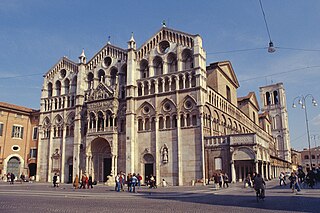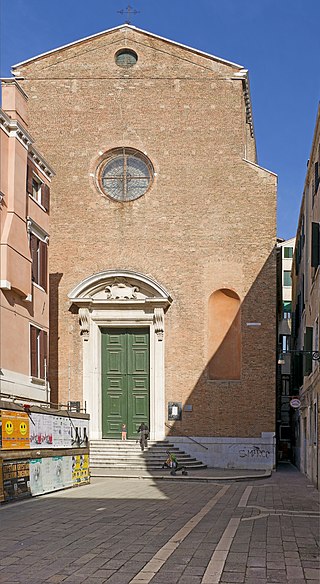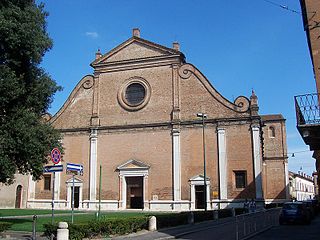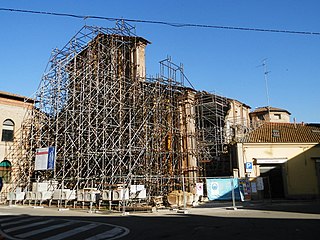
Girolamo Da Carpi was an Italian painter and decorator who worked at the Court of the House of Este in Ferrara. He began painting in Ferrara, by report apprenticing to Benvenuto Tisi ; but by age 20, he had moved to Bologna, and is considered a figure of Early Renaissance painting of the local Bolognese School.

Poggibonsi is a town in the province of Siena, Tuscany, Central Italy. It is located on the River Elsa and is the main centre of the Valdelsa Valley.

The Castello Estense or castello di San Michele is a moated medieval castle in the center of Ferrara, northern Italy. It consists of a large block with four corner towers.

Sant'Anna dei Lombardi,, and also known as Santa Maria di Monte Oliveto, is an ancient church and convent located in piazza Monteoliveto in central Naples, Italy. Across Monteoliveto street from the Fountain in the square is the Renaissance palace of Orsini di Gravina.

Santa Maria Maddalena dei Pazzi is a Renaissance-style Roman Catholic church and a former convent located in Borgo Pinti in central Florence, Italy.

Ferrara Cathedral is a Roman Catholic cathedral and minor basilica in Ferrara, Northern Italy. Dedicated to Saint George, the patron saint of the city, it is the seat of the Archbishop of Ferrara and the largest religious building in the city.

Antonio Randa was an Italian painter of the classicist period, active in Ferrara, Modena, Rovigo, Florence, Comacchio and his native Bologna.

San Benedetto is a late-Baroque architecture, Roman Catholic church and former Benedictine monastery in the city Catania, Sicily, southern Italy. The church facade faces Via Crociferi, parallels across via San Benedetto the former-Jesuit church of San Francesco Borgia, and both are about a block south along Crociferi from the church and convent of San Giuliano. Entrance to church and monastery appear to be through Piazza Asmundo #9 near the apse of the church.

San Pellegrino alla Sapienza o della Sapienza is a Gothic style, Roman Catholic church located at the intersection of via della Sapienza and via delle Terme in Siena, region of Tuscany, Italy. It is located across from the Teatro dei Rozzi.

Santa Maria della Fava, also originally known as Santa Maria della Consolazione, is an ancient Roman Catholic church in the sestiere of Castello in Venice, Italy.

The Ospedale degli Incurabili or Complesso degli Incurabili is an ancient and prominent hospital complex located on Via Maria Longo in central Naples, Italy. Part of the complex, including the remarkable pharmacy, are now the Museo delle arti sanitarie of Naples.

Sant'Elena, also sometimes called Santa Lena, is a Gothic-style, Roman Catholic church at the extreme east end of the sestiere of Castello in the City of Venice, Italy.

San Carlo Borromeo is a Baroque, Roman Catholic church located on Corso Giovecca #191, a block east of the Castello Estense in Ferrara, region of Emilia-Romagna, Italy.

Ferrara Charterhouse, of which the present Church of San Cristoforo alla Certosa was previously the monastic church, is a former charterhouse or Carthusian monastery built in Renaissance style, located on Piazza Borso 50 in Ferrara, Region of Emilia-Romagna, Italy. The monastery was suppressed in the time of Napoleon, but the church was reconsecrated in 1813 and remains in use. The site also accommodates a large municipal cemetery, which was established in 1813.

San Francesco is a late-Renaissance, Roman Catholic minor basilica church located on via Terranuova in Ferrara, Emilia-Romagna, Italy.

The Complesso di San Firenze is a 17th-century Baroque-style building, consisting of a church, palace, and former oratory, located on the southeast corner of the saucer-shaped piazza of San Firenze, located in the quartiere of Santa Croce in central Florence, region of Tuscany, Italy. The buildings were commissioned by the Oratorians of Saint Philip Neri.

San Domenico is a Baroque-style Roman Catholic church, located on Piazza San Domenico, and located in the ancient quarter of La Loggia, in central Palermo, region of Sicily, Italy. Piazza San Domenico opens to Via Roma a few blocks south of the large Palazzo delle Poste, and a few blocks north of Sant'Antonio Abate and Teatro Biondo, is the northern border of the warren of alleys of the Vucciria neighborhood. The church houses the burial monuments of many notable Sicilians, and is known thus as the Pantheon of illustrious Sicilians.

The church of San Francesco is a church located in Mirandola, in the province of Modena, Italy.

The Municipal Palace of Ferrara is located in Piazza del Municipio 2. It was the ducal residence of the Este family until the 16th century, when the court moved to the nearby Castello Estense. It is the seat of the municipality of Ferrara.

The temple of St. Francis is a Catholic place of worship in Gaeta, located in the historic center of the city, within the territory of the parish that lies over the cathedral of Saints Erasmus and Marcianus and St. Mary of the Assumption. The frescoes of the Temple of San Francesco were made by Vincenzo Petrocelli and Domenico Morelli.




















